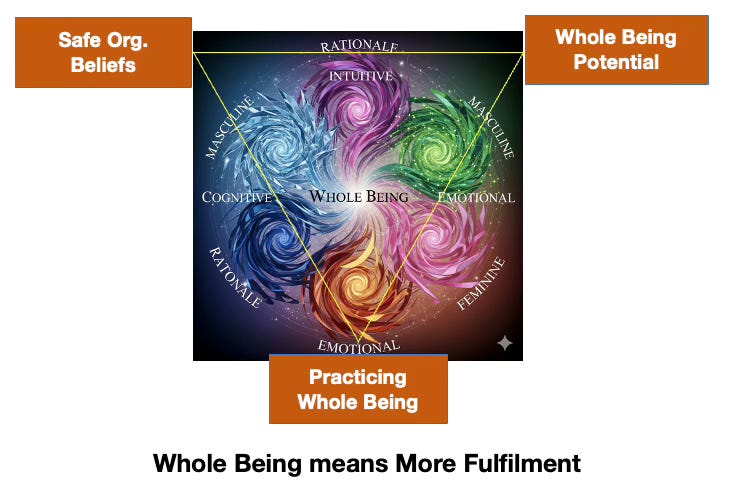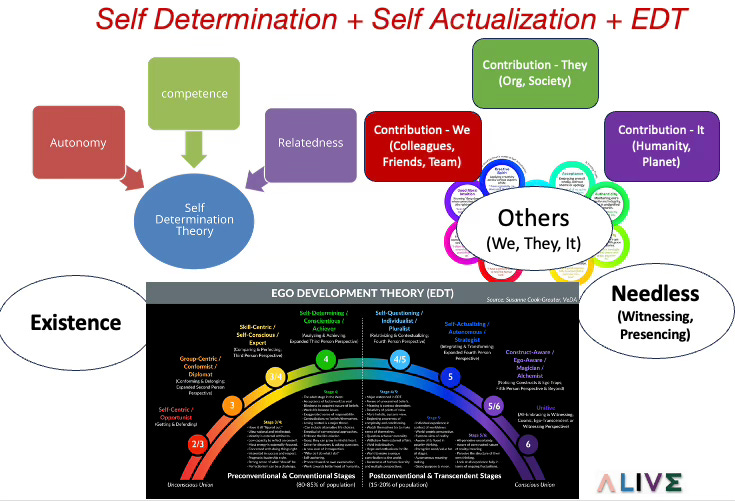The Return of the Whole
Every age has its hidden wound. Ours is fragmentation — the quiet separation of what once belonged together.
In modern organisations, people have been divided into parts: mind from heart, logic from intuition, work from meaning. We became performers of roles rather than participants in life.
The first pillar of an Alive Organisation is therefore an act of re-integration: the remembering that people are whole beings and that organisations exist to serve that wholeness. To awaken wholeness is to restore humanity to the centre of enterprise.
From Partial Selves to Whole Presence
A mechanistic organisation treats employees as functions: engineer, analyst, marketer, resource. It optimises parts and loses the person.
An Alive Organisation invites the whole presence of its people — body, mind, emotion, intuition, and spirit. It knows that innovation does not arise from fragmented intelligence but from integration.
Wholeness is not indulgence; it is efficiency of a higher order. When people can bring their entire self to work, energy once trapped in self-protection becomes available for creation.
The Inner Architecture of Wholeness
The Whole Being pillar rests on the understanding that every human action flows through a chain of inner forces:
Needs → Beliefs → Thinking → Emotion → Behaviour
At the base of this piece of work stand Primal Beliefs — our implicit answers to questions like “Is the world safe?” and “Is it alive?”
These beliefs start from needs: for safety, autonomy, connection, growth, self-actualisation.
Beliefs inform thoughts, which in turn drive behaviours and collective practices.
In an organisation, this same chain operates collectively. When the system believes the world is hostile, it produces defensive thinking and controlling practices.
When it believes life is safe and enticing, it creates trust and exploration.
Wholeness, therefore, is not a moral stance but a state of alignment among need, belief, thought, and action.
The Foundations in Human Science
Whole Being draws nourishment from several converging scientific roots:
Self-Determination Theory (SDT) — Ryan & Deci’s model showing that human motivation flourishes when three basic needs are met: autonomy, competence, and relatedness.
When organisations honour these needs, engagement becomes intrinsic.Self-Actualization Theory — From Maslow to Scott Barry Kaufman, this research reveals that humans grow toward creativity, morality, and meaning once basic safety is secure.
Self-actualization is not luxury; it is our design.Ego / Vertical Development Theory — As people mature, they integrate more perspectives and hold greater complexity.
Wholeness expands with consciousness; each new stage re-integrates what the previous one had to exclude.
Together these frameworks form the psychological foundation of the Whole Being pillar: growth is natural when fear recedes and consciousness widens.
The Three Movements of Whole Being
Within organisations, Wholeness unfolds through three reciprocal movements.
1. Safety — The Ground of Being
People must feel safe to be real. Psychological safety is not comfort; it is permission to experiment without humiliation. It turns fear into curiosity and control into collaboration.
2. Authenticity — The Expression of Being
Once safe, people begin to speak truth, show vulnerability, and align their outer roles with inner values. Authenticity becomes the new currency of trust.
3. Self-Fulfilment — The Expansion of Being
Finally, wholeness matures into self-fulfilment: the joy of contribution. Individuals sense that their growth and the organisation’s purpose are the same movement.
Safety opens the door, authenticity walks through it, and fulfilment turns the walk into a journey.
Organisational Wholeness
For an organisation, Whole Being means designing systems that mirror human psychology rather than deny it.
Such systems:
cultivate psychological safety as an operational metric;
embed learning and reflection within daily work;
allow roles to evolve with people’s growth;
honour emotions as data;
view conflict as energy for integration.
Leadership shifts from managing tasks to hosting development. The organisation becomes a container for human maturation.
The Practice of Integration
To embody Whole Being, organisations practise continual integration of opposites:
Holding these polarities consciously is itself a developmental practice. It turns the workplace into a space for awareness.
From Human Resources to Human Realities
“Human Resources” implies extraction: using people as means. “Whole Being” implies participation: seeing people as manifestations of life’s intelligence.
Alive Organisations replace the question “How do we get more from people?”
with “What wants to emerge through people?”. When that shift happens, metrics still matter — but they are guided by meaning, not fear.
The Gifts of Whole Being
When Wholeness becomes cultural DNA, several transformations follow:
Greater Resilience — people recover faster because they draw on inner coherence.
Sustainable Performance — energy arises from purpose, not pressure.
Creative Flow — the collective mind opens to intuition and play.
Deep Trust — relationships move from transaction to partnership.
Attraction of Talent — authenticity magnetises those who seek meaningful work.
These are not side effects; they are the natural physiology of aliveness.
The Ethical Dimension
Whole Being also redefines success. Profit remains vital, but as a measure of health, not as the reason for existence.
Ethics arise not from compliance but from consciousness — from the felt recognition that harm to another is harm to self. This realisation transforms business from competition for survival into collaboration for evolution.
A Living Definition
Whole Being is the organisational capacity to integrate safety, authenticity, and fulfilment, enabling people to express their complete humanity in service of a purpose larger than themselves.
It is the recognition that growth, connection, and contribution are not separate paths, but one continuous movement of life through human form.
Bridge to the Next Pillar
Wholeness is the soil in which the next pillar, Value Co-Creation, takes root. Once people are whole, they can meet others as equals and create value together rather than extract it from one another.
The next chapter explores this relational dimension of aliveness — how contribution at scale emerges when human wholeness meets shared purpose.
Enjoy reading and applying these content. If you’d like to receive additional information regarding Alive Organisations topic please subscribe below.




